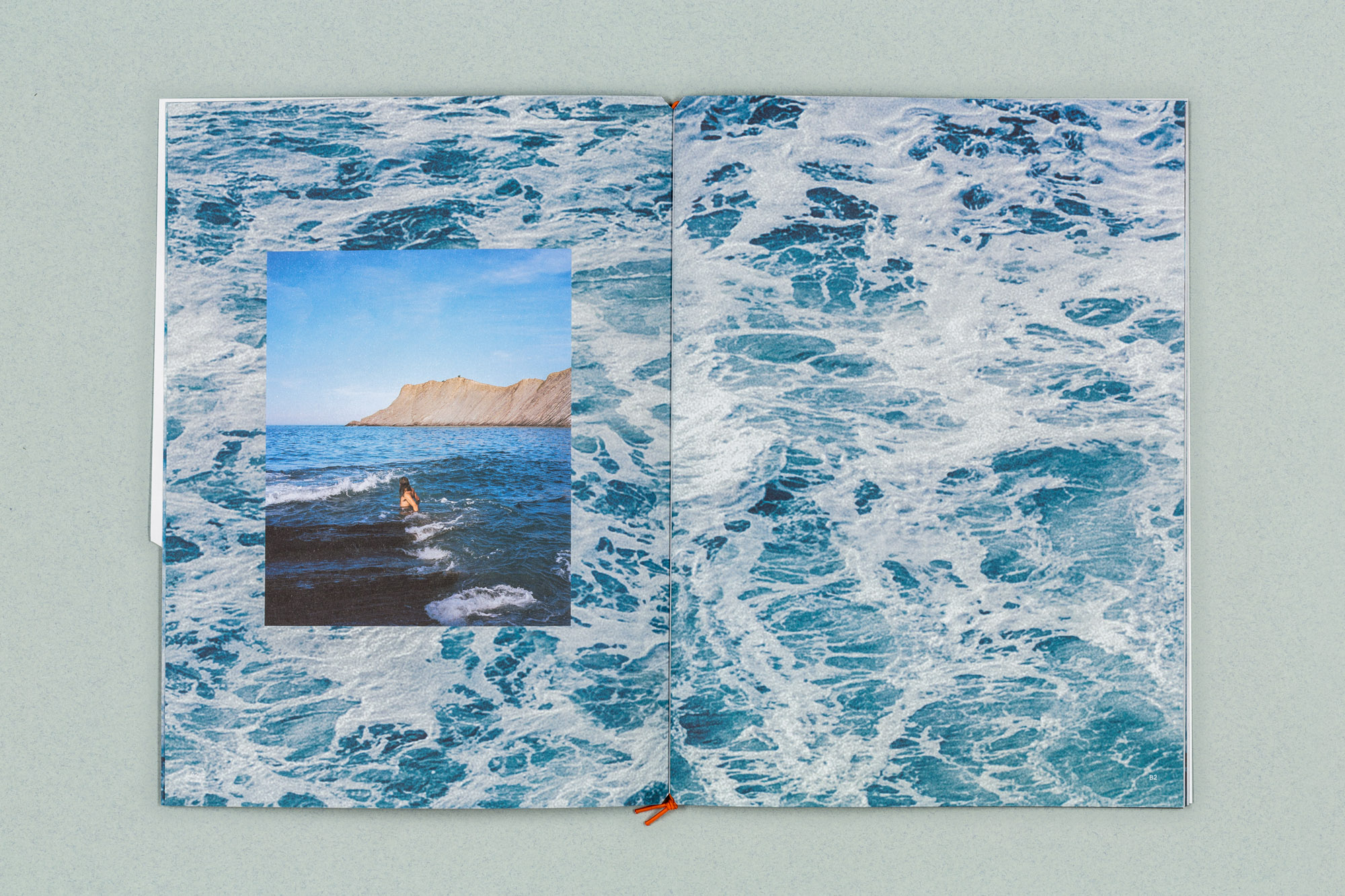Bidean 2018












Bidean 2018
ISBN 978-84-697-9427-2
Self-published, 2018
Editing: Miren Pastor, Víctor Garrido, Ander Pastor
Design: Tres Tipos Gráfico
Prepress: La Troupe
Printing: Artes Gráficas Palermo
Binding: Isabel Zambelli
Text: Iván del Rey de la Torre
32 pages
17 x 23,5 cm
Edition of 800 numbered copies
Produced with the support of the Publication Grant of the Basque Government
Bidean 2018
Bidean is a Basque word that refers to something or someone that is in the process of or on the path to; it symbolises the transition from adolescence to adulthood, searching for parallels between the ephemeral stages of life and the unstable cycles of nature.
These three self-published works are a fundamental tool used to structure this ongoing project and they fulfill a dual purpose: they are both books and exhibition resources. If you unbind them and follow the coordinates shown on each page, a representative mosaic of each stage appears, including a text by Iván del Rey de la Torre:
Through a complex system of wave emission and reception, adult cachalots produce clicking sounds that echo in their surroundings and then bounce back to them, allowing their brain to generate a type of ultrasound that, in the absence of a sharp conventional vision, helps them perceive what the space they occupy is actually like.
If those waves travel far enough and take sufficient time to return, a series of implausible images seemingly belonging to the past start to appear. However, these should not be interpreted as a déjà vu. Instead, it is important to understand that cachalots undergo a process similar to that of astronomers who contemplate the sky: due to the distance between them and stars they are studying, the light waves they analyse do not reflect the current reality, but a past one. Regardless of the sadness of the event, cachalots still choose to enjoy these images because, as painful as it may be, the slight feeling of having recovered a lost youth is also satisfying. Our own images, for that matter, are a soul-stirring journey to a past that becomes the present.
Images generated by cachalots from extremely straggling waves have revealed beaches, cliffs, streams, forests, mountains… visions they could not possibly have witnessed with their own eyes, which probably belonged to their ancestors, their mammal predecessors who chose to return to the sea or their great-great-grandparents, who might have even laid eggs at some point. Cachalots, therefore, transcend all the bodies that have culminated in their own. Is it possible that one day they might even return to the sea, to the times of the earliest life form? Could there be any use to this ability?
We have always been surrounded by images that are nothing but the melancholic act of stopping to look back at our footsteps, at the trace we leave behind.
Bidean, que en euskera significa que algo o alguien está en el proceso o en el camino, representa el salto de la adolescencia a la vida adulta, buscando paralelismos entre las efímeras etapas vitales y los ciclos inestables de la naturaleza.
Las tres autopublicaciones se han convertido en una herramienta clave para estructurar este proyecto río que sigue creciendo y cumplen una doble función, como libro y como recurso expositivo. Al desencuadernarlas y seguir las coordenadas indicadas en cada página, surge un mosaico representativo de cada etapa, acompañado de un texto de Iván del Rey de la Torre.
Gracias a un complejo sistema de emisión y recepción de ondas, el cachalote adulto es capaz de ejecutar unos clics que, una vez reflejados como eco en la realidad circundante, regresan al animal para que su cerebro genere una especie de ecografía; esta le hará sentir, a falta de una visión convencional clara, cómo es el espacio en el que se encuentra.
Si las ondas se alejan mucho, y tardan en regresar lo suficiente, empezamos a tener imágenes que resultan inverosímiles porque parecen venir de años atrás. Pero que nadie se confunda, no se trata de ningún déjà vu, a este cetáceo le sucede algo parecido a lo que les pasa a los astrónomos que observan el firmamento: las ondas de luz de las estrellas que analizan, dada su lejanía, no les muestran la realidad actual si no la del pasado. Al cachalote este suceso le resulta triste, pero le gusta recrearse en estas imágenes y es que, aunque dolorosa, la leve sensación de la juventud recobrada produce placer. También nuestras imágenes son el viaje conmovedor a un pasado hecho presente.
En imágenes del cachalote generadas por ondas extremadamente rezagadas se han llegado a observar playas, acantilados, arroyos, bosques, montes... visiones que es imposible que haya tenido con sus ojos, imágenes más propias de sus antepasados, sus bisabuelos mamíferos que tomaron la decisión de volver a sumergirse en el mar, sus tatarabuelos que se reproducían por huevos... Este animal, así, transciende todos los cuerpos que han culminado en el suyo. ¿Podrá retroceder tanto como para volver de nuevo al mar hasta los tiempos de la primera forma de vida? ¿Tendrá alguna función esta facultad?
Siempre han existido imágenes que no son más que el acto melancólico de pararse y volver la vista atrás para mirar las pisadas en el camino.
Bidean hitzak, zerbait edo norbait prozesuan edota martxan dagoela esan nahi du euskaraz, eta nerabezarotik adin heldura jauzia irudikatzen du, paralelismoak bilatuz bizitzako etapa iragankor eta naturako ziklo ezegonkorren artean.
Hiru argitalpenak hazten jarraitzen duen ibai proiektu hau egituratzeko funtsezko tresna bilakatu dira eta funtzio bikoitza betetzen dute, liburu bezala eta erakusketa baliabide gisa. Koadernaketa desegin eta orrialde bakoitzean adierazitako koordenatuak jarraituz, etapa bakoitzeko mosaiko adierazgarri bat agertzen da, Iván del Rey de la Torreren testu batez lagunduta:
Uhinak igortzeko eta jasotzeko sistema konplexu bati esker, kaxalote heldua gai da klik batzuk egiteko, eta behin bere inguruko errealitatearen oihartzun gisa islatu ondoren, animaliarengana itzultzen dira bere garunak ekografia moduko bat sor dezan; honek, ikuspegi konbentzional argirik izan ezean, berau dagoen espazioa nolakoa den sentiaraziko dio.
Uhinak asko urruntzen badira, eta itzultzeko denbora asko behar badute, sinesgaitzak diruditen irudiak izaten hasiko gara, urteetan atzera egindakoak diruditenak. Baina ez dadila inor nahasi, ez da inolako déjà vu-rik, zerua behatzen duten astronomoei gertatzen zaien antzerako zerbait gertatzen zaio zetazeo honi ere: behatzen dituzten izarren argi uhinak, dagokien urruntasunaren ondorioz, ez diete gaurko errealitatea erakusten, iragana baizik. Gertaera hau tamalgarria egiten zaio kaxaloteari, baina gustukoa du irudi hauetan birsortzea, nahiz eta mingarria izan, berreskuratutako gaztetasunaren sentsazio arinak plazerra sortzen du. Gure irudiak ere orainaldi bihurtutako iragan baterako bidaia hunkigarria dira.
Oso atzeratuta geratu diren uhinek sortutako kaxalotearen irudietan hondartzak, labarrak, ibaiak, basoak, mendiak... ikusi izan dira. Bere begiekin ikustea ezinezkoak diren irudipenak, bere arbasoengan ohikoagoak diren irudiak, berriro ere itsasoan murgiltzeko erabakia hartu zuten birraitona ugaztunak, arrautzen bidez ugaltzen ziren herenaitonak... Animalia honek, horrela, berarenean bihurtu diren gorputz guztiak hedatzen ditu. Lehen bizitza-aroaren garaietara arte itsasora itzultzeko bezainbeste atzera egin ahal izango du? Gaitasun honek funtzioren bat izango al du?
Beti egon izan dira gelditu eta begirada atzera itzultzeko ekintza malenkoniatsua baino ez diren irudiak, oinatzak bidean behatu ahal izateko.
*Inkjet printing Epson Ultrachrome in FineArt Paper HAHNEMÜHLE Photo Rag Baryta - 315g
%100 cotton
14x18cm
Edition of 100
